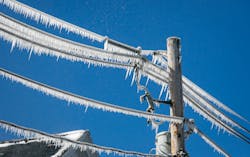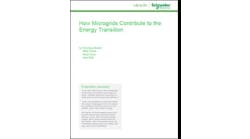Rural Electric Cooperatives Worry about Resiliency. A Call for Microgrids?
Rural electric cooperatives are worried about resiliency, but microgrids can help, as demonstrated by a number of projects now underway or completed.
In a teleconference that took place during the National Rural Electric Cooperative Association’s (NRCA) Power Xchange conference on March 3-8, four cooperative leaders expressed worries about resilience.
Jim Matheson, CEO of NRCA, which includes more than 900 electric cooperatives across 48 states serving 42 million total customers, explained that the cooperatives’ needs are different from those of most investor-owned utilities because they tend to serve rural regions with low population densities.
“What I'm hearing a lot from our members is concerns about reliability,” he said.
Examples of rural electric microgrids
A number of rural electric cooperatives across the country have commissioned or planned microgrids to help address reliability woes.
For example, take Anza Electric Cooperative, which is located in a fire-prone, high desert region of Southern California that’s often on public safety power shutoff (PSPS) watch during fire season.
The cooperative was 100% dependent on Southern California Edison (SCE) lines to import power. But in December 2020, the cooperative installed a microgrid that allows the cooperative to better operate on its own during PSPS and outages.
And Orcas Power & Light Cooperative (OPALCO) has set up a 500-kW solar microgrid on Decatur Island, one of several island microgrids planned for the San Juan Islands, off the coast of Washington.
What's reducing reserve margins?
During the teleconference, the cooperative executives said that the move to electrification is boosting demand, which is reducing cooperatives’ reserve margins. In addition, a number of generating plants are being taken offline in a “disorderly” fashion and being replaced with less capacity, no capacity or capacity that’s not always available, which impacts reliability. And third, it’s difficult for generation suppliers to site new generating plants due to permitting delays, Matheson said.
Interested in microgrids? Join us in Anaheim, California May 16-17 for Microgrid 2023: Lights On!
Meanwhile, tight supply chains are making it difficult to source components for transformers, substations and other equipment.
Matheson and the heads of the four cooperatives shared stories about power deficits during the storms that occurred last year from around Dec. 23-25.
There wasn’t enough gas in the pipeline on Dec. 24, and that sparked rolling blackouts in nine states, Matheson said.
For example, Old Dominion Electric Cooperative in Virginia had a contract for a firm supply of gas but there was no gas available to burn.
Chris Jones, CEO of Middle Tennessee Electric, said the cooperative acquires its electricity through the Tennessee Valley Authority, and that the December 2022 storms sparked rolling blackouts.
“I never thought I would say this, but these are different times and we are seeing capacity constraints across the board while we are in the midst of a rapid generation transition in our country now,” he said.
Backlog for transformers
Supply chain disruptions have sparked reliability concerns for Buddy Hasten, president and CEO of Arkansas Electric Cooperative. The transition to electrification and use of electric vehicles (EVs) is a major cause of the disruptions, he said.
If homebuilders need distribution transformers, they may need to wait up to two years, he said. If builders have no contract to acquire transformers, they have to cold call manufacturers and often wait as long as three years. Hasten said he’s heard stories about utilities that are swapping used transformers or installing them in places that aren’t exactly right for the transformer just so that developers can continue to build new neighborhoods.
People are being “forced” into the clean energy transition, and the supply challenges will only get worse due to the move to clean energy, he said.
Larger transformers used at the transmission level also have two- to three-year wait lists, he said. Utilities are buying equipment faster than it can be restocked.
Hasten said he supports the clean energy transition but it’s happening too fast. He called for stepping back and ensuring there’s enough electrical equipment to meet the needs of the distributed energy that’s coming online. Blackouts are becoming very real and common, he said.
Rolling blackouts for the first time
In fact, during a cold snap, the cooperative for the first time had to implement rolling blackouts because there wasn’t enough power available on the grid.
“For us in Arkansas, for the first time in our cooperative’s over 80-year history, we had to go out and open breakers and substations to plunge members into the dark,” he said.
The December storms cost the cooperative $100 million due in part to high gas prices.
“If you can't start a Tennessee Titans game on time because you don't have electricity, I think that’s pretty serious,” he said.
Winter Storm Elliott also took its toll on Kansas Electric Power Cooperative, said Suzanne Lane, executive vice president and CEO of the cooperative.
Fuels face disruption
Fuel availability has become a major issue for the cooperative, especially when renewables don’t always produce energy.
“Contrary to popular belief, the wind doesn't always blow in Kansas, right? Sun isn't always shining for solar. Natural gas isn't always flowing and coal isn’t always being delivered,” she said. And because of drought conditions, hydropower isn’t always available.
As cooperatives struggle with reliability, one new option available to them is the direct pay mechanism in the Inflation Reduction Act. That means that non-profit cooperatives that previously couldn’t take advantage of the Investment Tax Credit are now eligible to receive them as direct payments that are the value of the tax credit, said NRCA’s Matheson. It gives cooperatives the opportunity to own assets directly; they usually acquire power through power purchase agreements, he said.
A bare cupboard
But while cooperatives are working to secure their own power, reliability concerns haunt them.
“I think there is really starting to be some real chinks in the reliability wall where there could come the right storm, the right set of conditions and all of a sudden you may go to the cupboard and it's bare. That's a big deal,” said Arkansas Electric’s Hasten.








